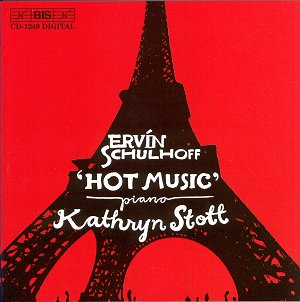Czech composer Ervín Schulhoff is enjoying something
of a flowering. His music now turns up on concert programmes with
more regularity: see my reviews of Midori’s account of the Violin
Sonata (http://www.musicweb-international.com/SandH/2002/Aug02/midori.htm)
and Gottlieb Wallisch’s performance of the Piano Concerto (http://www.musicweb-international.com/SandH/2001/Nov01/youth.htm).
Czech record company Supraphon has also issued a fair number of
discs of Schulhoff’s music. He has been further highlighted as part
of the group of composers who were forced to attend concentration
camps. Most famous of these camps, possibly, is Theresienstadt,
although Schulhoff was to meet his end in Wülzburg.
Schulhoff numbered Reger as one of his teachers,
although his music encompassed a diversity of styles. The title
of the present disc, ‘Hot Music’, points towards the jazz influences
which preoccupied him. Schulhoff was introduced to jazz by the
Dadaist artist George Grotz. Of course, this was one factor that
troubled the Nazis (because of the African-American element).
Tellingly, Schulhoff wrote in 1919 that, ‘Music should first and
foremost produce physical pleasures’: much of the music on this
disc adheres to this, even becoming slinkily sensual at times.
The six movements of the Suite dansante de
jazz collectively provide the best, most approachable introduction
to Schulhoff imaginable. The bright ‘Stomp’ which opens the group
and the swing of ‘Strait’ contrast well with the ‘Waltz’, which
at 4’22 benefits from being the longest movement. Stott brings
care and delicacy as well as swing and panache to her reading.
Lasting almost the same amount of time as the
Suite, the First Piano Sonata (of five Schulhoff completed) is
made up of one span, subdivided into several sections. Stott provides
really considered, prepared playing: all the notes of the tricky
first section speak with a clarity that enables the piece to buzz
with energy. The Molto tranquillo, contrasting in mood, is a lovely
quasi-improvisation that is nevertheless not at all diffuse. Instead,
it is spellbinding in its progress towards its climax. Although
the finale brims with energy, it is the ‘Allegro moderato grotesco’
that is the highlight. True to the grotesque indication, it also
manages to be playful, with a lovely touch in its final gestures,
which lead directly into the last movement.
The Cinq Etudes de jazz is (compositionally)
quite held back, perhaps surprisingly given the title. The first
movement is recognisably a Charleston, but a virtuoso one. The
final ‘Toccata sur le shimmy ‘Kitten on the keys’’ is similarly
impressive, and these frame three affecting pieces, including
a remarkably delicate Tango.
The figure of J. S. Bach is invoked in the Toccatina
of the Second Suite of 1924 (where Stott’s fingerwork is
quite simply remarkable). Per Broman’s excellent booklet notes
refer to the influence of Ravel on this piece. Indeed Tombeau
de Couperin (1917) does seem to lurk around in the shadows.
Interestingly, the eleven Inventions are
notated minus barlines. This piece is dedicated to Ravel. The
booklet notes state that here Schulhoff’s music lies closer to
Debussy and indeed, and separately, my own listening notes referred
to Cathédrale engloutie in relation to the first
Invention of the set (marked, ‘Lento’). The final movement is
marked, ‘Allegro brutalemente’, as opposed to ‘martellato’, although
the effect is similar. Perhaps the most interesting is the capricious
ninth Invention, Presto leggiero, although at 26 seconds, blink
and you miss it.
The Hot Music elaborates and extends the
syncopations of the ragtime genre, taking it to various regions
(China in the case of No. 5!).
Musically, this disc is perfectly arranged to
provide an entertaining eighty minutes of listening. As an interpreter,
Stott is near-ideal (her previous recordings for Conifer had already
confirmed her status). Strongly, enthusiastically recommended.
Colin Clarke
